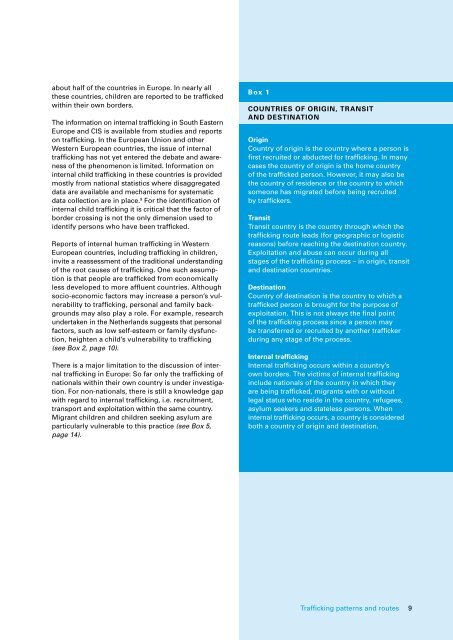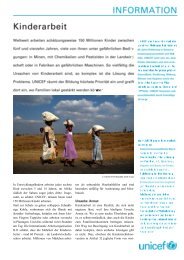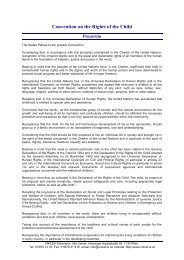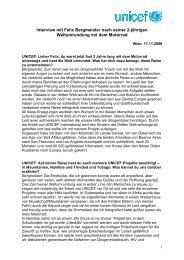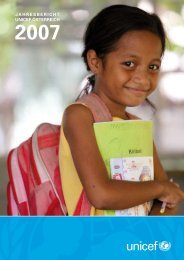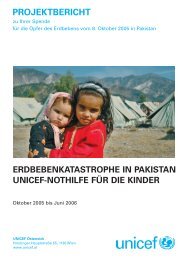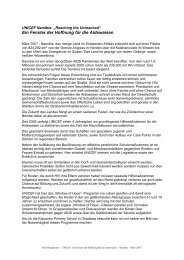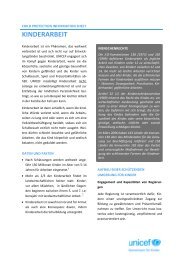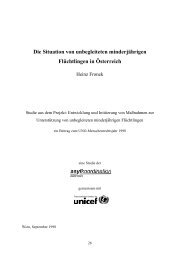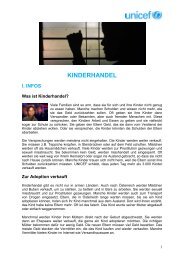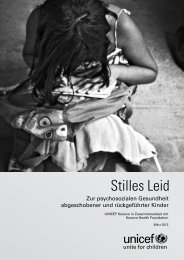Child Trafficking in Europe
Child Trafficking in Europe
Child Trafficking in Europe
You also want an ePaper? Increase the reach of your titles
YUMPU automatically turns print PDFs into web optimized ePapers that Google loves.
about half of the countries <strong>in</strong> <strong>Europe</strong>. In nearly all<br />
these countries, children are reported to be trafficked<br />
with<strong>in</strong> their own borders.<br />
The <strong>in</strong>formation on <strong>in</strong>ternal traffick<strong>in</strong>g <strong>in</strong> South Eastern<br />
<strong>Europe</strong> and CIS is available from studies and reports<br />
on traffick<strong>in</strong>g. In the <strong>Europe</strong>an Union and other<br />
Western <strong>Europe</strong>an countries, the issue of <strong>in</strong>ternal<br />
traffick<strong>in</strong>g has not yet entered the debate and awareness<br />
of the phenomenon is limited. Information on<br />
<strong>in</strong>ternal child traffick<strong>in</strong>g <strong>in</strong> these countries is provided<br />
mostly from national statistics where disaggregated<br />
data are available and mechanisms for systematic<br />
data collection are <strong>in</strong> place. 9 For the identification of<br />
<strong>in</strong>ternal child traffick<strong>in</strong>g it is critical that the factor of<br />
border cross<strong>in</strong>g is not the only dimension used to<br />
identify persons who have been trafficked.<br />
Reports of <strong>in</strong>ternal human traffick<strong>in</strong>g <strong>in</strong> Western<br />
<strong>Europe</strong>an countries, <strong>in</strong>clud<strong>in</strong>g traffick<strong>in</strong>g <strong>in</strong> children,<br />
<strong>in</strong>vite a reassessment of the traditional understand<strong>in</strong>g<br />
of the root causes of traffick<strong>in</strong>g. One such assumption<br />
is that people are trafficked from economically<br />
less developed to more affluent countries. Although<br />
socio-economic factors may <strong>in</strong>crease a person’s vul-<br />
nerability to traffick<strong>in</strong>g, personal and family backgrounds<br />
may also play a role. For example, research<br />
undertaken <strong>in</strong> the Netherlands suggests that personal<br />
factors, such as low self-esteem or family dysfunction,<br />
heighten a child’s vulnerability to traffick<strong>in</strong>g<br />
(see Box 2, page 10).<br />
There is a major limitation to the discussion of <strong>in</strong>ternal<br />
traffick<strong>in</strong>g <strong>in</strong> <strong>Europe</strong>: So far only the traffick<strong>in</strong>g of<br />
nationals with<strong>in</strong> their own country is under <strong>in</strong>vestigation.<br />
For non-nationals, there is still a knowledge gap<br />
with regard to <strong>in</strong>ternal traffick<strong>in</strong>g, i.e. recruitment,<br />
transport and exploitation with<strong>in</strong> the same country.<br />
Migrant children and children seek<strong>in</strong>g asylum are<br />
particularly vulnerable to this practice (see Box 5,<br />
page 14).<br />
Box 1<br />
CounTriEs of orig<strong>in</strong>, TransiT<br />
and dEsT<strong>in</strong>aTion<br />
orig<strong>in</strong><br />
Country of orig<strong>in</strong> is the country where a person is<br />
first recruited or abducted for traffick<strong>in</strong>g. In many<br />
cases the country of orig<strong>in</strong> is the home country<br />
of the trafficked person. However, it may also be<br />
the country of residence or the country to which<br />
someone has migrated before be<strong>in</strong>g recruited<br />
by traffickers.<br />
Transit<br />
Transit country is the country through which the<br />
traffick<strong>in</strong>g route leads (for geographic or logistic<br />
reasons) before reach<strong>in</strong>g the dest<strong>in</strong>ation country.<br />
Exploitation and abuse can occur dur<strong>in</strong>g all<br />
stages of the traffick<strong>in</strong>g process – <strong>in</strong> orig<strong>in</strong>, transit<br />
and dest<strong>in</strong>ation countries.<br />
dest<strong>in</strong>ation<br />
Country of dest<strong>in</strong>ation is the country to which a<br />
trafficked person is brought for the purpose of<br />
exploitation. This is not always the f<strong>in</strong>al po<strong>in</strong>t<br />
of the traffick<strong>in</strong>g process s<strong>in</strong>ce a person may<br />
be transferred or recruited by another trafficker<br />
dur<strong>in</strong>g any stage of the process.<br />
<strong>in</strong>ternal traffick<strong>in</strong>g<br />
Internal traffick<strong>in</strong>g occurs with<strong>in</strong> a country’s<br />
own borders. The victims of <strong>in</strong>ternal traffick<strong>in</strong>g<br />
<strong>in</strong>clude nationals of the country <strong>in</strong> which they<br />
are be<strong>in</strong>g trafficked, migrants with or without<br />
legal status who reside <strong>in</strong> the country, refugees,<br />
asylum seekers and stateless persons. When<br />
<strong>in</strong>ternal traffick<strong>in</strong>g occurs, a country is considered<br />
both a country of orig<strong>in</strong> and dest<strong>in</strong>ation.<br />
<strong>Traffick<strong>in</strong>g</strong> patterns and routes 9


